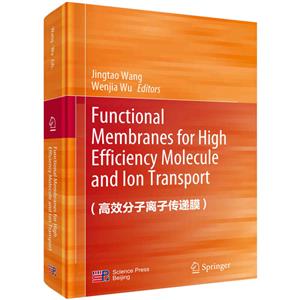-
>
宇宙、量子和人类心灵
-
>
气候文明史
-
>
南极100天
-
>
考研数学专题练1200题
-
>
希格斯:“上帝粒子”的发明与发现
-
>
神农架叠层石:10多亿年前远古海洋微生物建造的大堡礁
-
>
声音简史
高效分子离子传递膜(英文版) 版权信息
- ISBN:9787030748867
- 条形码:9787030748867 ; 978-7-03-074886-7
- 装帧:一般胶版纸
- 册数:暂无
- 重量:暂无
- 所属分类:>
高效分子离子传递膜(英文版) 内容简介
本书结合作者团队的近期新研究成果,重点介绍了有机-无机复合膜和二维层状膜在有机溶剂纳滤、氢燃料电池、锂-硫电池中的应用,分析了分子和离子级分离膜技术与膜过程领域的发展现状、存在问题及优化方法,提出了膜过程中离子/分子级分离与传递过程强化的策略。本书的出版将对改善该学科的知识体系,明确该学科前言研究现状与进展,促进膜分离技术与膜过程领域的发展具有积极意义。同时,本书也可为该领域的研究人员和工程师提供新的技术研发思路。
高效分子离子传递膜(英文版) 目录
1 Introduction to Membrane 1
Jingtao Wang and Wenjia Wu
2 Composite Membrane for Organic Solvent Nanofiltration 7
Wenpeng Li, Shiyuan Liu, and Jingjing Chen
3 Lamellar Membrane for Organic Solvent Nanofiltration 65
Xiaoli Wu, Yifan Li, and Jingtao Wang
4 Composite Proton Exchange Membrane for Hydrogen Fuel Cell 103
Guoli Zhou, Jingchuan Dang, and Jingtao Wang
5 Lamellar and Nanofiber-Based Proton Exchange Membranesfor Hydrogen Fuel Cell 167
Jianlong Lin, Wenjia Wu, and Jingtao Wang
6 Composite Separator or Electrolyte for Lithium-Sulfur Battery 219
Weijie Kou, Jiajia Huang, and Wenjia Wu
7 Composite Electrolyte for All-Solid-State Lithium Battery 253
Jie Zhang, Yafang Zhang, and Jingtao Wang
高效分子离子传递膜(英文版) 节选
Chapter 1 Introduction to Membrane Jingtao Wang and Wenjia Wu In the past decades, membrane technology has been widely utilized in various separation processes, because of their low-energy consumption, low-cost, reliability, and scalability when compared with conventional separation processes like distillation, extraction, or crystallization [1,2]. In order to further increase the competitiveness, intensive efforts have been made from improving the separation efficiency of existing membrane processes to exploring new applications. As the core part, membrane materials with high permeability, high selectivity, and high stability are extremely desired since they can significantly accelerate the practical application of membrane technology [3, 4]. To date, plenty of membranes with different pore sizes have been developed, such as polymer membrane, ceramic membrane, two-dimensional (2D) lamellar membrane, molecule sieving membrane, hybrid membrane, and composite membrane [5-10]. These membranes have been widely used for different separation processes including, microfiltration, ultrafiltration, nanofiltration, reverse osmosis, gas separation, and proton/ion conduction, etc. [11, 12]. For each category of membrane, the physical and chemical environments of transfer channels are of great importance in manipulating the comprehensive properties. The physical environments are dictated by the connectivity, tortuosity, and size of transfer channels, while the chemical environments are dictated by the type, amount, and distribution of functional groups within transfer channels [13]. Generally, ideal transfer channels should integrate the following attributes: (i) they should be short with appropriate transfer environment to endow membranes with high permeability, (ii) the channel size distribution should be narrow to endow membranes with high selectivity, and (iii) the chemical and mechanical stability should be high to endow membranes with long-term operation stability [14]. Currently, polymers are the dominant membrane materials, due to their easy processability and high scale-up capability. For conventional polymer membranes, breaking the permeability-selec-tivity or permeability-stability trade-off remains a challenge. The great progress in polymer membranes over the past decades has brought about the booming of novel kinds of structured membranes including, hybrid membrane, composite membrane, and phase-separated membrane, which push the separation performances of polymer membranes to new records [15-18]. Hybrid membrane is an intricately structured membrane configuration, owing to its merit of coupling the good flexibility and processability of polymers with the regular topological structure as well as the tunable functionality of fillers [19, 20]. Impermeable fillers such as silica particles, graphene oxide (GO) nanosheets, and organic/inorganic nanorods can induce a distortion of chain alignment to improve the free volume property or induce the construction of long-range, ordered transfer channels in membrane [21,22]. Permeable fillers such as metal-organic frameworks (MOFs), covalent organic frameworks (COFs), and zeolite can afford additional transfer pathways and mechanisms to membrane including, molecule sieving, and selective adsorption [23, 24]. Composite membrane for molecule transfer is generally a heterogeneous membrane with dense separation layer and porous support layer, where the separation layer and the support layer can be separately optimized to achieve simultaneously high separation performance and stability [25,26]. Particularly, the fabrication of composite membrane with an ultrathin separation layer is deemed as a delicate strategy to achieve highly permeable membrane, which is one of the most important pursuits for membrane technology [27, 28]. At present, researches related to composite membranes mainly focus on the precise manipulation of physical structure and chemical component of separation layer; however, these remain challenging due to the pursuit of ultrathin thickness. For proton/ion separation, electrospinning is increasingly recognized as a powerful mean for introducing unique phase-separated architectures into composite membranes [29]. Indeed, it allows the elaboration of composite membranes with a rather facile mean to control of the long-range organization/distribution/percolation ofhydrophilic and hydrophobic domains of the ionomer by adjusting the type of electrospun material, the volume fraction of nanofibers, and the experimental conditions [30]. Moreover, electrospinning can impart uniaxial alignment of polymer chains within nanofibers, resulting in enhanced mechanical properties. Importantly, it can promote the formation of interconnected transfer channels, which facilitate the improvement in proton/ion conduction [31]. In recent years, 2D nanosheets, with a thickness of one to a few atoms, have become the promising building blocks for ad
- >
苦雨斋序跋文-周作人自编集
苦雨斋序跋文-周作人自编集
¥6.1¥16.0 - >
史学评论
史学评论
¥14.4¥42.0 - >
伯纳黛特,你要去哪(2021新版)
伯纳黛特,你要去哪(2021新版)
¥16.9¥49.8 - >
人文阅读与收藏·良友文学丛书:一天的工作
人文阅读与收藏·良友文学丛书:一天的工作
¥15.7¥45.8 - >
新文学天穹两巨星--鲁迅与胡适/红烛学术丛书(红烛学术丛书)
新文学天穹两巨星--鲁迅与胡适/红烛学术丛书(红烛学术丛书)
¥9.9¥23.0 - >
月亮虎
月亮虎
¥15.4¥48.0 - >
中国人在乌苏里边疆区:历史与人类学概述
中国人在乌苏里边疆区:历史与人类学概述
¥21.6¥48.0 - >
经典常谈
经典常谈
¥16.7¥39.8
-
有机化学史话
¥19.4¥68 -
高效分子离子传递膜(英文版)
¥126.4¥160 -
化学
¥8.6¥20 -
化学的秘密-趣味科学-插图版
¥17.5¥25 -
高分子化学-(第五版)
¥10¥30 -
不良情绪应急处理包--孤独感
¥12.9¥30
龙争虎斗中国史:宋朝传奇
¥6.0¥14.2周易相学通解
¥11.2¥33.9我的第一本科学漫画书:科学发明王:15.最喜欢的发明(彩绘版)
¥25.5¥35.0空间绳系机器人飞行控制技术
¥92.2¥128.0写给孩子的二十四节气
¥20.8¥55.0

















